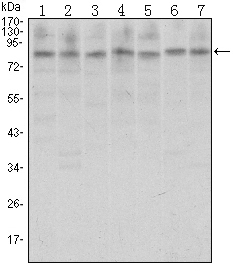CTCF Monoclonal Antibody
- Catalog No.:YM0173
- Applications:WB;ELISA
- Reactivity:Human;Monkey
- Target:
- CTCF
- Gene Name:
- CTCF
- Protein Name:
- Transcriptional repressor CTCF
- Human Gene Id:
- 10664
- Human Swiss Prot No:
- P49711
- Mouse Swiss Prot No:
- Q61164
- Immunogen:
- Purified recombinant fragment of human CTCF expressed in E. Coli.
- Specificity:
- CTCF Monoclonal Antibody detects endogenous levels of CTCF protein.
- Formulation:
- Liquid in PBS containing 50% glycerol, 0.5% BSA and 0.02% sodium azide.
- Source:
- Monoclonal, Mouse
- Dilution:
- WB 1:500 - 1:2000. ELISA: 1:10000. Not yet tested in other applications.
- Purification:
- Affinity purification
- Storage Stability:
- -15°C to -25°C/1 year(Do not lower than -25°C)
- Other Name:
- CTCF;Transcriptional repressor CTCF;11-zinc finger protein;CCCTC-binding factor;CTCFL paralog
- Molecular Weight(Da):
- 83kD
- References:
- 1. J Mol Med. 2008 Sep;86(9):1057-66.
2. J Exp Med. 2008 Apr 14;205(4):785-98.
3. EMBO J. 2008 Feb 20;27(4):654-66.
- Background:
- This gene is a member of the BORIS + CTCF gene family and encodes a transcriptional regulator protein with 11 highly conserved zinc finger (ZF) domains. This nuclear protein is able to use different combinations of the ZF domains to bind different DNA target sequences and proteins. Depending upon the context of the site, the protein can bind a histone acetyltransferase (HAT)-containing complex and function as a transcriptional activator or bind a histone deacetylase (HDAC)-containing complex and function as a transcriptional repressor. If the protein is bound to a transcriptional insulator element, it can block communication between enhancers and upstream promoters, thereby regulating imprinted expression. Mutations in this gene have been associated with invasive breast cancers, prostate cancers, and Wilms' tumors. Alternatively spliced transcript variants encoding different isoforms have been
- Function:
- function:Transcriptional repressor binding to promoters of vertebrate c-myc gene. Also binds to the PLK and PIM1 promoters. May prevent the access of transcriptional activators to enhancers. Also acts as a transcriptional activator of APP. Involved in different aspects of gene regulation including promoter activation or repression, hormone-responsive gene silencing, methylation-dependent chromatin insulation, and genomic imprinting. Seems to act as tumor suppressor.,similarity:Belongs to the CTCF zinc-finger protein family.,similarity:Contains 11 C2H2-type zinc fingers.,subunit:Interacts with CHD8.,tissue specificity:Ubiquitous. Absent in primary spermatocytes.,
- Subcellular Location:
- Nucleus, nucleoplasm . Chromosome . Chromosome, centromere . May translocate to the nucleolus upon cell differentiation. Associates with both centromeres and chromosomal arms during metaphase. Associates with the H19 ICR in mitotic chromosomes. May be preferentially excluded from heterochromatin during interphase.
- Expression:
- Ubiquitous. Absent in primary spermatocytes.
- June 19-2018
- WESTERN IMMUNOBLOTTING PROTOCOL
- June 19-2018
- IMMUNOHISTOCHEMISTRY-PARAFFIN PROTOCOL
- June 19-2018
- IMMUNOFLUORESCENCE PROTOCOL
- September 08-2020
- FLOW-CYTOMEYRT-PROTOCOL
- May 20-2022
- Cell-Based ELISA│解您多样本WB检测之困扰
- July 13-2018
- CELL-BASED-ELISA-PROTOCOL-FOR-ACETYL-PROTEIN
- July 13-2018
- CELL-BASED-ELISA-PROTOCOL-FOR-PHOSPHO-PROTEIN
- July 13-2018
- Antibody-FAQs
- Products Images

- Western Blot analysis using CTCF Monoclonal Antibody against A31 (1), MCF-7 (2), HeLa (3), HCT116 (4), Jurkat (5), NIH/3T3 (6), and Cos7 (7) cell lysate.



